JAPAN GUIDE - LITTLE KNOWN
JAPAN GUIDE Sightseeing (Mt.Fuji) Hotel Spa Foods Train Blog 中国語
SERVICE Package Tours Guide & Assitant Experience Special Interest Tour
Private Car Other Arrangements
Japan Guide Sight Seeing
Our Style Little Known Great Spot in Japan
The place where we who am Japanese eagerly interested in.
Tohoku Region
Nuruyu Spa, Kuroiashi city, Aomori pref.
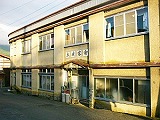
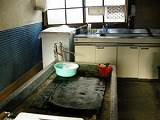
Nuru-yu Spa has the history more than 400 years. It is located in the west of Kuroishi city,
Aomori prefecure. There are some Lodge called "Kyakusha" surrounding the big public
spa. The hot spring is rustic with a quiet atmosphere. "Kyakusha" is lodge for person who is
treating disease in spa staying for a long term. Visitors use public spa outside, so there is
no bath in the lodge. The word of "Kyakusha" is probably peculiar to hot springs in Aomori
region.
Ginzan Onsen( Spa ), Yamagata pref.(5h30 from Tokyo by car)
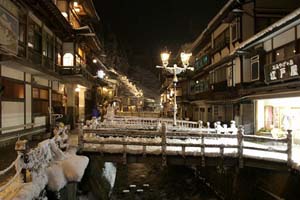
Ginzan Onsen(hot spring) is the traditional spa where it's from a city in Obanazawa-shi,
Yamagata about 19 km in mountains in the east. The Japanese-style hotel wooden with
three story, four story on both sides around a clear stream on the Ginzan river, stand in
narrow space.
Kabukuri Numa(Marsh), Miyagi pref. (5hours from Tokyo by car)
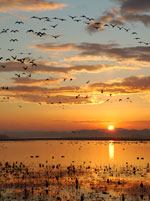
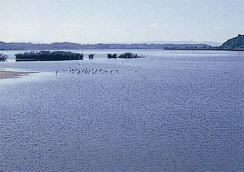
Izu marsh and Uchi marsh locate in low wetlands of the border of Kurihara City and Tome
city, Miyagi pref. As this area has little snow, it is known as the coming place of the migratory
birds such as the swan and flying from Siberia because the marsh does not do freerze.
It was appointed to the natural monument of the country in 1967, and Izu marsh , next to
Kushiro for 1985 years, was secondly appointed Ramsar Convention registered ground.
And "the Kabukuri marsh and neighboring rice fields" became designated registration damp
ground in 2005. It is unusual for neighboring rice fields including the damp ground to be
registered worldwide.
Kanto Region
Saru-hashi(Monkey Bridge),Yamanashi pref.) (1h20 from Tokyo by car)
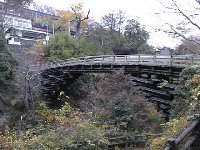
It is one of the three major 'strange' bridges* in Japan.
Chubu Region
Aoni Villege(4hours from Tokyo by car)
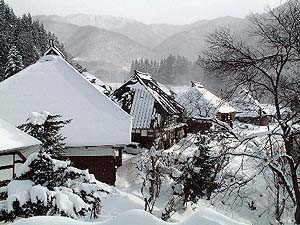
A mountain villege above the sea level 760m. A thatched house built from Edo era last years
till Meiji era is left. The village is wrapped in the color of the four seasons and harmonizes
with "Tanada" (Shelf-shaped rice field) spreading through the circumference and "Sekibutsu"
(The Budda of stone) crowd to be dotted with and can stream down traditional Japanese
farm village scenery in now. In addition, it is a photogenic point to view "Tanada", Hakuba villege
and the mountains of the north Alps over a village.
Omaki Onsen(Hot springs), Toyama pref.
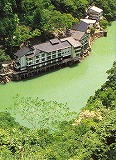 Onsen Ryokan(hotel) where you cannot reach wihtout triding a ship.
Onsen Ryokan(hotel) where you cannot reach wihtout triding a ship.In 1183, Now around 800 years ago, a Samurai escapes from attack of Genji Heike, when he
demaded a hideout and wandered in Omaki, he discovered a hot spring springing out of the
banks of a river and have cured a wound with the hot water. It is said that it is the origin of
Omaki hot spring. The village sank into the bottom of the lake with completion of Komaki Dam,
and, in 1930, only one inn was left behind. The reason is because it was born from the history
that is a thing of these that it is said "one inn of the unexplored region which cannot go unless I
use the ship". 100 Japanese large Maki hot springs which were chosen as the one of excellent
hot water harmonize with nature, and the heart that is over relaxedly whether the luxurious
space where there is nothing is stillness is a hot spring feeling at ease.
Omaki Onsen Kanko Ryokan
Posted Rate : 21,150yen ~ Twin room per night per person including breakfast & dinner
Anrakuji temple, Nagano pref.(3hours from Tokyo by car)
 The Three Storeyed Pagoda
The Three Storeyed Pagoda 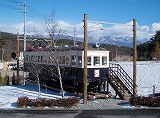 The round window train
The round window trainThe Three Storeyed Pagoda of Anrakuji was built in Kamakura Era in last years. Anrakuji
temple is a Rinzai sect temple founded near Bessho Hot spring, and Kencho-ji Temple and
have strong relations of Kenchoji in Kamakura close. The Three Storeyed pagoda is thought
about on the existing only octagonal plane in the days of Kamakura with the later period by a
stylistic characteristic. It is the styles of the full-scale Zen Buddhism such as roof of slow
covering the roof with shingles, radial rafter.
Shimoguri Villege, Nagano pref.(4h30 from Tokyo by car)
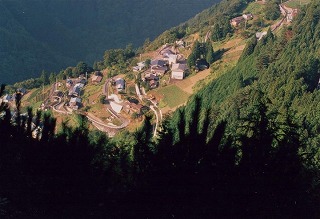
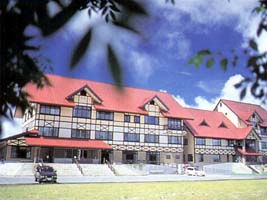
Hitel Highland Shirabiso, now closed and reopen in April.
Shimoguri village is located in Shimoina-county, Nagano pref. of 1000m above the sea level
seeing the Southern Alps of Japan. This land which was opened up the hillside slanting
toward 30 degrees. This is called "Japanese Tirol" as the ground where Japanese original
scenery is left.
*Road to Shimoguri villege is closed now in the winter season.
Kansai Region
Chugoku Region
Fukiya, Okayama pref.(3h30 from Osaka by car)
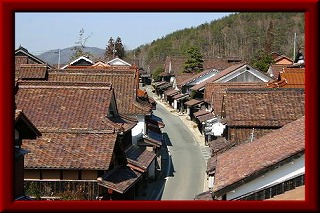
Fukiya is one of seven villages in Okayama Prefecture designated as a "Hometown Village".
Fukiya's most characteristic feature is the uniformity of its architecture. The streets are lined
with old homes and storefronts with burnt-red and mustard-colored walls of bengara,black
siding charred to protect against the elements and rooftops of distinctive calico brown and red
tiles.
Kintai-kyo bridge, Yamaguchi pref.
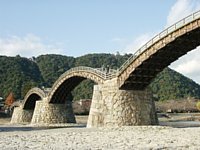

It is one of the three major 'strange' bridges* in Japan.
Shikoku Region
Kazura bridge(4hours from Osaka by car)
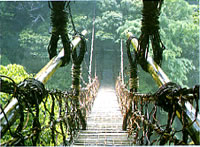
Kazura-bashi (Vine Bridge) is located at Nishi-Iya village, Miyoshi city, Tokushima Pref.
It is one of the three major 'strange' bridges* in Japan. The bridge is a primitive uspension
type using vines like 'shirakuchi' vines.
*Please refer to Saruhashi in KANTO & kintaikyo in CHUGOKU.
Kyushu Region
Tsujunkyo bridge, Kumamoto pref.(2hours from Fukuoka by car)
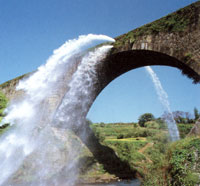
Tsujunkyo bridge has completed it under technology, contribution and effort of local farmers in
1854, Perry's coming by his black ship in the Edo Period. It is located in Kyushu Aso-san
famous for a caldera crater. The bridge is for the water in which water poured through an
expert water pipe not for people walking on it. An arch style bridge is admitted a very important
structure, so it was designated as a national important cultural asset in 1960.
Japan Tour Planning Inc.